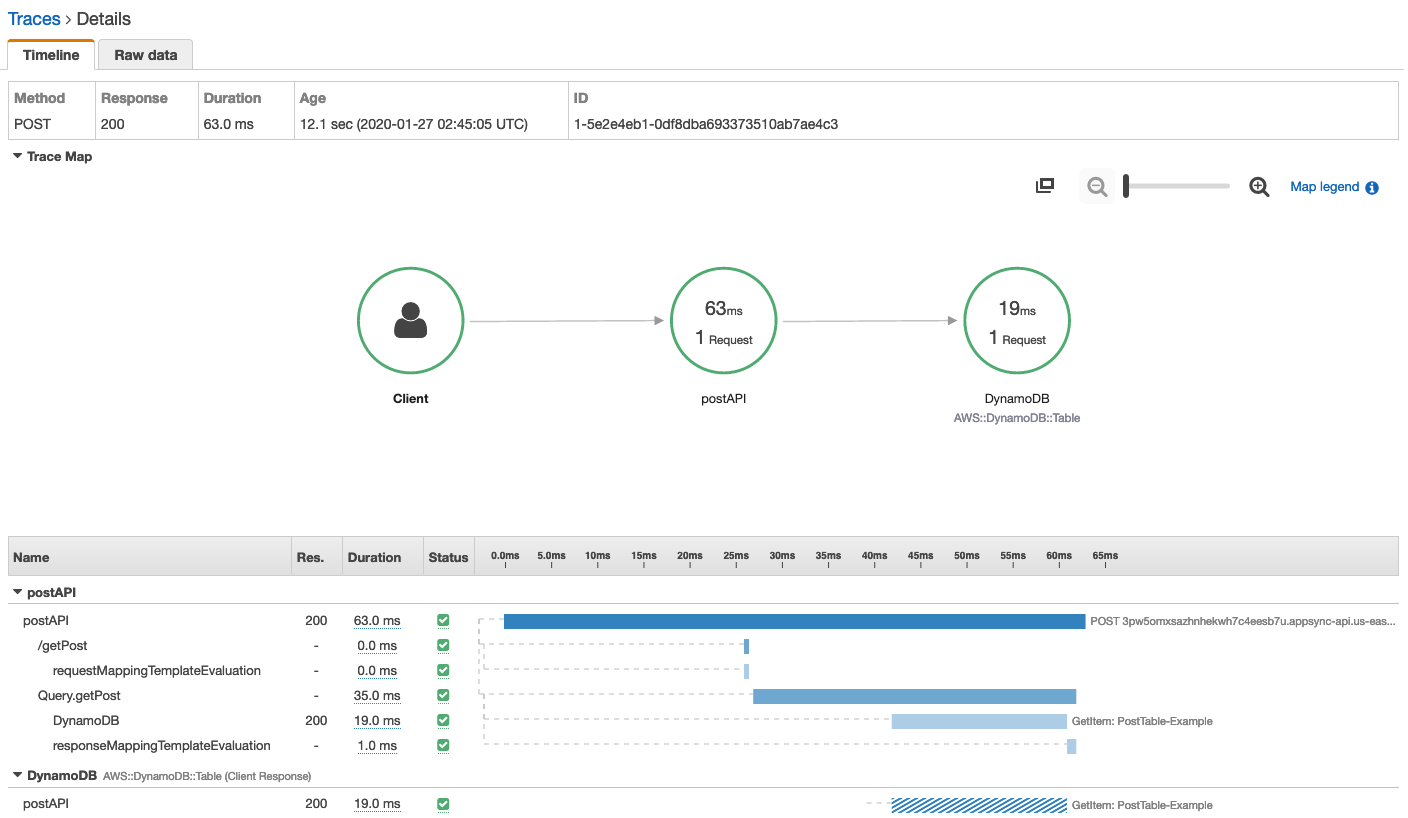Using Amazon X-Ray to trace requests in Amazon AppSync
You can use Amazon X-Ray to trace requests as they are executed in Amazon AppSync. You can use X-Ray with Amazon AppSync in all Amazon Regions where X-Ray is available. X-Ray gives you a detailed overview of an entire GraphQL request. This enables you to analyze latencies in your APIs and their underlying resolvers and data sources. You can use an X-Ray service map to view the latency of a request, including any Amazon services that are integrated with X-Ray. You can also configure sampling rules to tell X-Ray which requests to record, and at what sampling rates, according to criteria that you specify.
For more information about sampling in X-Ray, see Configuring Sampling Rules in the Amazon X-Ray Console.
Setup and Configuration
You can enable X-Ray tracing for a GraphQL API through the Amazon AppSync console.
-
Sign in to the Amazon AppSync console.
-
Choose Settings from the navigation panel.
-
Under X-Ray, turn on Enable X-Ray.
-
Choose Save. X-Ray tracing is now enabled for your API.
If you’re using the Amazon CLI or Amazon CloudFormation, you can also enable X-Ray tracing
when you create a new Amazon AppSync API, or update an existing Amazon AppSync API, by
setting the xrayEnabled property to true.
When X-Ray tracing is enabled for an Amazon AppSync API, an Amazon Identity and Access Management service-linked role is automatically created in your account with the appropriate permissions. This allows Amazon AppSync to send traces to X-Ray in a secure way.
Tracing Your API with X-Ray
Sampling
By using sampling rules, you can control the amount of data that you record in
Amazon AppSync, and can modify sampling behavior on the fly without modifying or
redeploying your code. For example, this rule samples requests to the GraphQL API with
the API ID 3n572shhcpfokwhdnq1ogu59v6.
-
Rule name —
test-sample -
Priority —
10 -
Reservoir size —
10 -
Fixed rate —
10 -
Service name —
* -
Service type —
AWS::AppSync::GraphQLAPI -
HTTP method —
* -
Resource ARN —
arn:aws:appsync:us-west-2:123456789012:apis/3n572shhcpfokwhdnq1ogu59v6 -
Host —
*
Understanding Traces
When you enable X-Ray tracing for your GraphQL API, you can use the X-Ray trace
detail page to examine detailed latency information about requests made to your API. The
following example shows the trace view along with the service map for this specific
request. The request was made to an API called postAPI with a Post type,
whose data is contained in an Amazon DynamoDB table called
PostTable-Example.
The following trace image corresponds to the following GraphQL query:
query getPost { getPost(id: "1") { id title } }
The resolver for the getPost query uses the underlying DynamoDB data
source. The following trace view shows the call to DynamoDB, as well as the latencies of
various parts of the query’s execution:

-
In the preceding image,
/getPostrepresents the complete path to the element that is being resolved. In this case, becausegetPostis a field on the rootQuerytype, it appears directly after the root of the path. -
requestMappingTemplateEvaluationrepresents the time spent by Amazon AppSync evaluating the request mapping template for this element in the query. -
Query.getPostrepresents a type and field (inType.fieldformat). It can contain multiple subsegments, depending on the structure of the API and the request being traced.-
DynamoDBrepresents the data source that is attached to this resolver. It contains the latency for the network call to DynamoDB to resolve the field. -
responseMappingTemplateEvaluationrepresents the time spent by Amazon AppSync evaluating the response mapping template for this element in the query.
-
When you view traces in X-Ray, you can get additional contextual and metadata information about the subsegments in the Amazon AppSync segment by choosing the subsegments and exploring the detailed view.
For certain deeply nested or complex queries, note that the segment delivered to X-Ray by Amazon AppSync can be larger than the maximum size allowed for segment documents, as defined in Amazon X-Ray Segment Documents. X-Ray doesn’t display segments that exceed the limit.